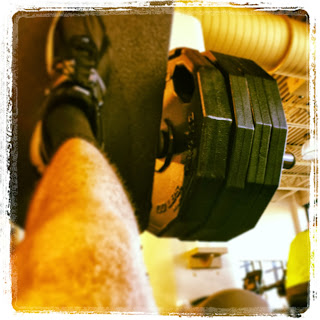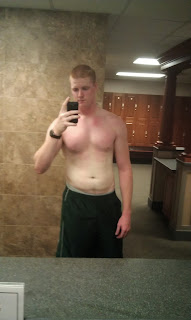The Bod Pod has me weighing at 199 lbs with 16% body fat. Based on it's calculations, 31lbs of my 199lbs was FAT. Unreal to me but the numbers don't lie. My logic to my percentage being so much higher is because since my contest, I've been more liberal in my diet, I've cut out cardio because I'm working on gaining more weight during my "bulk" and I'm taking supplements such as creatine and beta-aline which are known for retaining water.
With that being said, I am in the best season for the bodybuilding world - BULK SEASON :)
Pretty much, this is the point in your lifting cycle where your goal is to gain as much mass as you can, mainly lean muscle mass so that when you "cut" again, you will look bigger, leaner, and better on stage.
When you start bulking a few things change up. For me, it means death to most cardio. I love doing cardio, but at the same time, it's hard for me to gain weight if I'm running because of the amount of calories I burn when doing my cardio. Many people may agree or disagree with my logic, but this has worked for me and I continue to practice little to no cardio during my bulk.
Another thing I change up is my diet. I increase my overall macronutrient goals so now I'm taking in nearly 3000 calories a day shooting for about 300 grams of Protein! This is when you develop a love-hate relationship with your diet because now you need to eat more but in turn, you spend more on groceries. I'm trying to do a "clean" bulk where I'm still being smart on my food choices and where I'm getting my calories from. This is in hopes that it will reduce the amount of fat I put on during my bulk so it will be a faster and leaner cutting period once I start to lose the excess weight again.
My workouts change too. I have decreased the amount of repetitions in my workouts from between 8-15 reps depending on the workout to 4-8 reps depending on the workout. I do this so I can lift heavier and build more mass. A classic rule of thumb to gain mass is to lift heavy in small repetitions while you want to lift a moderately light weight for many repetitions if you want to get leaner and tone up.
I'm still lifting 5-6 days a week and focusing on two body parts a day.
This bulking season I'm working hard on increasing the size in my legs and back because I felt that those were the two big things I lacked on stage for my contest. I want to make my legs borderline bodybuilder size and have enough mass on my back that you can see more than just my traps, delts, and lats when I do my back pose.
If things work out I want to shoot for another show in June. The NPC East Coast Classic and the Maryland State Championships is June 18th so that's what I have my sights set on. Whether I'm doing a show in June or not I'm going to schedule my lifting and cutting so I am show ready by June because at the very least I'll be ready for the beach :P
My supplementation has changed a good amount too. To give you an Idea here's a breakdown of my ideal day as far as protein intake and what my supplementation is - Notice I still gain most of my nutrition form food. Do not use supplements as your sole source of nutrition! There is a reason why they're called "supplements".
Morning:
Wake up:
I take the following in pill form: Creatine, Fenugreek, Multivitamin, Yohimbine, Fish Oil, CLA, Lysine, L-Arginine, Chromium
Then I take 2 scoops of Optimum Nutrition's 100% Whey Protein - About 48g Protein.
Breakfast:
1 cup liquid egg whites - 27g protein
6oz nonfat greek yogurt - 18g protein
slice of all wheat toast with Crazy Richard's Peanut Butter - About 13g Protein
1/2 cup old fashioned oats - 5g protein
Snack:
1 scoop whey protein - 24g protein
Lunch:
Take the following pills: CLA, L-Arginine, Fish Oil, Chromium, Lysine, Yohimbine
8oz Chicken Breast - 52g protein
Sweet Potato - 2g protein
Salad - 2g Protein
Gym:
Pre Workout - 2 scoops Beast Sports "Beast Mode" and Glutamine
Intra-Workout - 2 Scoops Cellucor BCAA
Post Workout - 1 scoop whey protein - 24g Protein and Glutamine
Snack:
Peanut Butter on an Unsalted Rice Cake / 6oz nonfat greek yogurt with granola - 30g protein
Dinner:
4oz Chicken Breast - 26g Protein
Sweet Potato - 2g Protein
Mixed Vegetables - 2g Protein
Pre-Bed Snack:
Pills: L-Arginine
2 scoops Optimum Nutrition 100% Casein Protein - 48g protein
Daily Protein Total: 323 grams
I try to shoot for this every day. I also shoot for about 200g carbs and about 65g fat.
I'm living on the road and out of hotel rooms for the next month so it is a challenge to find food that I can travel with. Fortunately I have done this enough that I can easily prep meals even in my hotel room with just a microwave, refrigerator, and sink. With the help of my 6-Pack Bag It makes traveling on the road doable.
I have a long way to go but I'm pushing every day to be better than what I was yesterday.
If anyone has any questions please feel free to comment here or message me on my page at :https://www.facebook.com/iwant2btheinspiration <---don't forget to like it too!

















